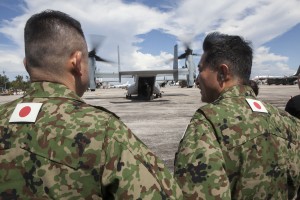11/15/2013: Philippine Air Force Sgt. Alex Deoric, assigned to the 520th Air Base Wing, guides a MV-22B Osprey carrying supplies and personnel from Villamor Air Base, Manila, to areas affected by Typhoon Haiyan, Nov. 14.
The U.S. and Philippine Armed Forces have transported more than 384,400 pounds of relief supplies and more than 1,735 displaced personnel.
Currently there are four KC-130J Hercules aircraft assigned to Marine Aerial Refueler Transport Squadron 152, and eight additional MC-130’s assigned to the Joint Special Operations Task Force-Philippines (JSOTF-P) assisting with airlift.
The militaries of the two nations have partnered and trained together for decades, which prepare both forces for the challenges associated with extreme circumstances.
[slidepress gallery=’ospreys-and-c-130js-depart-from-villamor-air-base-manila’]
Credit: III MEF:11/14/13
According to a US Marine Corps Forces, Pacific press release on November 13, 2013:
24/7 FLIGHT OPERATIONS IN/OUT OF TACLOBAN
U.S. military relief flights in support of the U.S. Agency for International Development (USAID) and Government of the Philippines are now operating around the clock. The airfield in Tacloban City is now “24/7 capable,” and the U.S. military began 24-hour operations Nov. 13, said Brig. Gen. Paul Kennedy, 3d Marine Expeditionary Brigade (MEB) commander, and on-site commander of U.S. military relief efforts.
The U.S. military has conducted approximately 40 flights in support of Operation DAMAYAN (“Help in Time of Need” in Tagalog), inserting more than 400 relief workers from USAID, its Office of U.S. Foreign Disaster Assistance (OFDA), and nongovernment organizations. The joint relief efforts have also airlifted more than 800 displaced people.
Over the next 24 hours, 3d MEB is preparing to receive approximately 180,000 pounds of USAID relief supplies, including plastic sheeting, hygiene kits, food and water, which will be distributed to areas in need.
There are currently eight MV-22B Ospreys assigned to Marine Medium Tiltrotor Squadron 262, part of 1st Marine Aircraft Wing, III MEF, based in Okinawa, Japan, operating in the Philippines. Both the MV-22s and 6 KC-130J aircraft will continue to ferry relief workers and USAID-provided supplies, and airlift displaced people.
The MV-22B Osprey, a tiltrotor aircraft being used to transport relief supplies and personnel, provides a unique advantage in this type of humanitarian assistance/disaster relief operation due to its vertical takeoff and landing capabilities, giving it access to locations not reachable by fixed wing aircraft. Its ability to quickly convert to “airplane mode” makes possible for it to fly at much higher speeds than that of traditional helicopters.


